
Cornus canadensis is a species of flowering plant in the dogwood family Cornaceae, native to eastern Asia and North America. Common names include Canadian dwarf cornel, Canadian bunchberry, quatre-temps, crackerberry, and creeping dogwood. Unlike its relatives, which are for the most part substantial trees and shrubs, C. canadensis is a creeping, rhizomatous perennial growing to about 20 centimetres tall.

Mespilus canescens, commonly known as Stern's medlar, is a large shrub or small tree, recently discovered in Prairie County, Arkansas, United States, and formally named in 1990. It is a critically endangered endemic species, with only 25 plants known, all in one small wood, now protected as the Konecny Grove Natural Area.

Vaccinium reticulatum, known as ʻōhelo ʻai in Hawaiian, is a species of flowering plant in the heather family, Ericaceae, that is endemic to Hawaii. It grows at altitudes of 640–3,700 m (2,100–12,140 ft) on lava flows and freshly disturbed volcanic ash on Maui and Hawaiʻi, and less commonly on Kauaʻi, Oʻahu, and Molokaʻi. Adaptations to volcanic activity include the ability to survive ash falls of over 25 cm (9.8 in) depth.

Eriogonum fasciculatum is a species of wild buckwheat known by the common names California buckwheat and flat-topped buckwheat. Characterized by small, white and pink flower clusters that give off a cottony effect, this species grows variably from a patchy mat to a wide shrub, with the flowers turning a rusty color after blooming. This plant is of great benefit across its various habitats, providing an important food resource for a diversity of insect and mammal species. It also provides numerous ecosystem services for humans, including erosion control, post-fire mitigation, increases in crop yields when planted in hedgerows, and high habitat restoration value.

Hakea salicifolia commonly known as the willow-leaved hakea, is species of flowering plant that is endemic to eastern Australia. It is an adaptable, fast growing small tree or shrub with attractive foliage and cream white flowers.

Hakea bakeriana is a shrub in the family Proteaceae and is endemic to the Central Coast of New South Wales. It is a dense shrub with sharply pointed, cylinder-shaped leaves and pink to crimson flowers in groups of between four and twelve. The fruit is a rough, wrinkled follicle which terminates in a short beak.

Swainsona galegifolia commonly known as smooth Darling pea, is a species of flowering plant in the family Fabaceae and is endemic to Australia. It is a small shrub with greyish-green leaves and flowers in white, red, pink, purple, yellow or orange.

Hakea trifurcata, commonly known as two-leaf, two-leaved hakea, or kerosene bush, is a shrub, endemic to the south-west of Western Australia. The species has two leaf forms, needle-like or oblong egg-shaped. Unlike most hakea species the fruit remain green at maturity and resemble the broader leaf form. The mimicry creates a camouflage, reducing predation of the seed by granivores in particular cockatoos.

Amomyrtus meli, known as meli, is a species of tree endemic to Chile in the family Myrtaceae. It grows from Arauco to Chiloe. It grows mostly on moist and shaded sites.
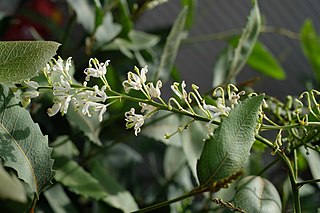
Lomatia ilicifolia, commonly known as holly lomatia or native holly, is a plant in the family Proteaceae and is endemic to south-eastern Australia. It is a stiff, erect shrub with hairy, rust-coloured new growth and which recovers from fire from a lignotuber. It has dull green, leathery, prickly, holly-like leaves and long sprays of cream flowers, usually after fire.
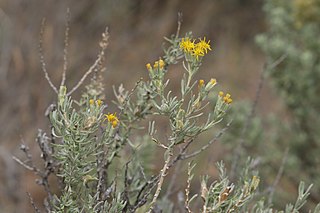
Tetradymia argyraea is a species of flowering plant in the aster family known by the common names spineless horsebrush and gray horsebrush. It is native to western North America.
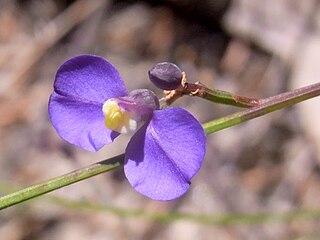
Comesperma sphaerocarpum, commonly known as the broom milkwort, is an Australian plant in the milkwort family. Inconspicuous unless in flower, it grows from 10 to 30 cm high. The stems are ridged and usually leafless, and arise from the plant's woody base. The rarely seen leaves are at the base of the shoot. They are thick in texture, and measure 8 mm long by 2 mm wide. This plant first appeared in scientific literature in Plantae Preissianae in 1846, authored by the German botanist Joachim Steetz.

Petrophile canescens, commonly known as conesticks, is a species of flowering plant in the family Proteaceae and is endemic to eastern Australia. It is an erect shrub with pinnately-divided leaves and oval heads of hairy, white to pale cream-coloured flowers.

Vicia orobus is a species of leguminous plant in the genus Vicia, known as wood bitter-vetch. It is found in Atlantic areas of Europe, especially in the rocky edges of seasonally-grazed fields. It grows up to 60 cm (24 in) tall, and has no tendrils at the ends of its pinnate leaves. Its flowers are white with purple veins, and are borne in groups of 6 or more.
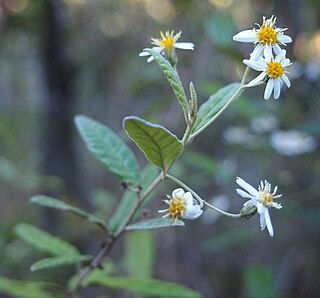
Olearia canescens is a species of flowering plant in the family Asteraceae and is endemic to eastern Australia. It is a shrub with scattered elliptic or egg-shaped leaves, and white and yellow, daisy-like inflorescences.

Hakea collina is a shrub in the Proteaceae native to eastern Australia. A small many branched shrub with gnarled branches with attractive cream-yellowish flowers.

Scorzonera libanotica, also known as the Lebanese salsify and Lebanese viper's grass is a perennial member of the genus Scorzonera in the family Asteraceae.
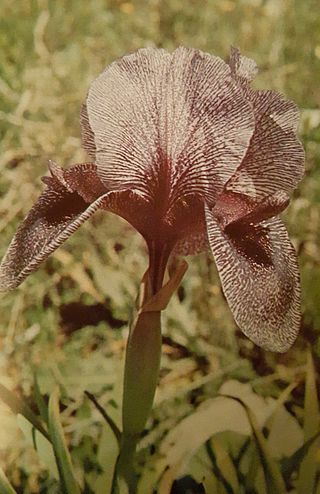
Iris susiana, commonly known as the mourning iris, is a species of perennial plant in the family Iridaceae. The mourning iris is native to the Middle East. It grows in Lebanon, Syria and Turkey, although it is believed to be extinct in the wild. It is popular as a cut flower as the flowers can easily span 12 centimeters. The survival of the species is seriously threatened by excessive picking.

Eucalyptus canescens, commonly known as the Ooldea Range mallee or Beadell's mallee, depending on subspecies, is a species of mallee that is endemic to southern Australia. It has rough bark from the base of the trunk to the thicker branches, smooth bark on the thin branches, egg-shaped to lance-shaped adult leaves, flower buds in groups of between seven and eleven, creamy white flowers and smooth cup-shaped to conical, and sometimes ribbed fruit.
Pomaderris clivicola is a species of flowering plant in the family Rhamnaceae and is endemic to a restricted area of Queensland. It is a multi-stemmed shrub with softly-hairy twigs, egg-shaped leaves, and small panicles of yellow to cream-coloured flowers.


















